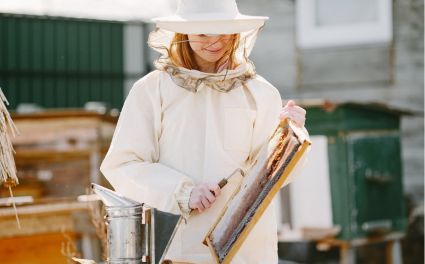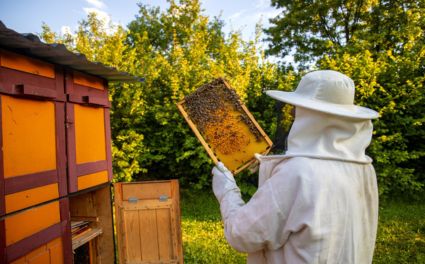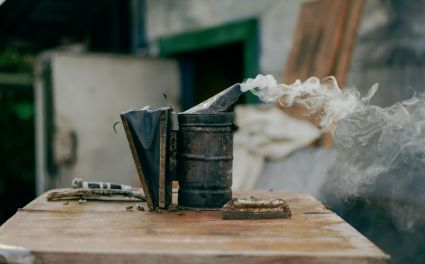Bees play an essential role in maintaining ecological balance and supporting global agriculture. Their pollination activities ensure the reproduction of flowering plants, fruits, and crops, making them one of the most valuable insects on Earth. But one common question both beginners and experienced beekeepers often ask is: “How long do bees live?”
The answer depends on several factors, including their species, environment, and role within the colony. Understanding these variations helps beekeepers practice better hive management, improve colony health, and contribute to bee conservation.
Understanding the Lifespan of Bees
The lifespan of honey bees varies significantly depending on their function and environmental conditions. Within a hive, there are three main types of bees — queen bees, worker bees, and drones — each with a distinct role and life expectancy.
Honey bees, particularly Apis mellifera, are the most studied species in modern Learn Beekeeping programs due to their economic and agricultural value. Depending on their duties and seasonal factors, their lives may span from a few weeks to several years.
Worker Bee Lifespan
Worker bees, which make up the majority of the colony, generally live about six weeks during peak foraging seasons such as summer. They spend the first few weeks inside the hive tending to larvae and cleaning cells, and later venture out to collect nectar and pollen.
However, worker bees born in late autumn often survive much longer — up to six months — as they are responsible for maintaining hive warmth and ensuring the colony’s survival through winter.
Queen Bee Lifespan
The queen bee enjoys the longest lifespan in the colony, living anywhere from two to five years under optimal conditions. Her primary role is reproduction — she can lay up to 2,000 eggs per day, ensuring a steady population of honey bees.
Her health and fertility are critical for the colony’s success. Beekeepers must monitor her performance closely during hive inspections, often using protective beekeeping jackets for safety.
Drone Bee Lifespan
Drones, the male bees, live the shortest lives — typically around eight weeks. Their sole purpose is to mate with a virgin queen during her nuptial flight. Once they fulfill this role, they die immediately after mating.

Factors Affecting the Lifespan of Bees
Several variables influence how long bees live, ranging from natural environmental challenges to human-driven factors such as agricultural practices and urbanization.
1. Environmental Impact on Bees
Environmental stress plays a major role in determining bee longevity. Exposure to pesticides, habitat destruction, and extreme weather can shorten bee lifespans and disrupt their behavior.
Beekeepers can help reduce these risks by using quality Beekeeping Equipments, maintaining proper ventilation, and keeping hives insulated during colder months.
2. Bee Species Lifespan
Different species show significant variations in lifespan. For example, bumblebee vs honeybee comparisons reveal that bumblebees generally have shorter lifespans — a few weeks to months — while honey bees can live for years under favorable conditions.
To explore more species differences, read Difference Between Honey Bee and Bumble Bee.
3. Bee Life Cycle
The bee life cycle — from egg to adult — determines overall longevity. Worker bees and drones develop faster than queens, typically emerging within 21–24 days, while queens mature in about 16 days.
Using breathable beekeeping veils allows beekeepers to safely observe these stages without disturbing the hive.
The Role of the Queen, Worker, and Drone Bees
Each bee type contributes uniquely to the colony’s function and longevity:
-
Queen bees ensure continuity by reproducing and maintaining colony balance.
-
Worker bees handle hive maintenance, feeding, and defense.
-
Drone bees provide genetic diversity through mating.
Healthy colonies rely on all three castes functioning optimally. Wearing durable beekeeping gloves during hive inspections helps prevent stings while protecting delicate comb structures.
Impact of Beekeeping Practices on Bee Lifespan
Beekeeping techniques directly influence bee longevity. Modern practices such as supplemental feeding, pest control, and hive hygiene help extend lifespans.
Sustainable management — using natural treatments and avoiding chemical sprays — also promotes stronger colonies. Protective beekeeping suits enable safe handling, reducing stress on the bees.
For young learners, comfortable beekeeping kids suits help them participate safely and understand the Lives of Bees.
Pollinator Lifespan and Its Importance
Role of Bees in Pollination
Pollination is essential for plant reproduction, and bees are nature’s most effective pollinators. Their lifespan directly affects how long they can pollinate crops and wildflowers.
When identifying whether you’re seeing a bee nest or a wasp nest, understanding species behavior helps protect both bees and biodiversity.
How Lifespan Affects Pollination Efficiency
Shorter lifespans mean reduced pollination cycles. Long-living worker bees ensure consistent foraging, improving yields and ecological balance. Ensuring hive health — by using breathable beekeeping trousers and providing adequate food — maintains productivity.
Learn more about nectar collection in How Do Bees Collect Honey?.
Ensuring Bee and Beekeeper Safety
While focusing on bee lifespan, a beekeeper’s protection is equally vital. Bees can become defensive during inspections, so full-body coverage is essential.
Secure beekeeping ankle protection and even stylish pink bee suits ensure safety and comfort during hive work.
For detailed insights on gear performance, see Do Bee Suits Protect from Wasps?.

The Importance of Quality Beekeeping Gear
OZ Armour is widely recognized for producing durable, ventilated, and comfortable protective wear. From lightweight jackets to breathable veils and reinforced gloves, every product supports safe and sustainable beekeeping.
Wearing dependable suits helps prevent injuries during hive care or when removing a bee sting. High-quality gear ensures both beekeeper comfort and bee calmness — reducing stress and improving colony health.
Conclusion
The question “How long do bees live?” has no single answer. Lifespan varies with species, climate, and management. Queens may live for years, while worker bees often survive for weeks — yet all are essential to the hive’s harmony.
By adopting sustainable practices, using trusted protective gear from OZ Armour, and maintaining hive hygiene, beekeepers can enhance colony longevity.
Healthy, long-living bees strengthen ecosystems, increase pollination, and support biodiversity. For more insights on topics like bumblebee vs carpenter bee, difference between a beehive and a wasp nest, and hive maintenance, visit Read More Blogs About Beekeeping.




